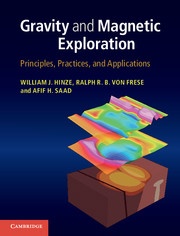1 - Introduction
Published online by Cambridge University Press: 05 May 2013
Summary
Overview
Geophysics, the science of the physics of the Earth from its magnetosphere to the deep interior, is useful in characterizing the subsurface Earth. Solid-Earth geophysics employs techniques involving the measurement of force fields to study subsurface features and the processes that act upon them. Thus, geophysical studies serve a broad variety of geologic, natural resource, engineering, and environmental purposes. Gravity and magnetic methods, which measure very small spatial and temporal changes in the terrestrial gravity and magnetic force fields, have a wide range of uses from submeter to global scales. Although these methods in most cases fail to match the resolution and precision of direct observations, they are rapid, cost-effective, and non-invasive procedures of studying the inaccessible Earth and optimizing the location of drill holes for direct studies and other remote sensing studies which have higher resolution capabilities.
The application of gravity and magnetic methods generally involves a common approach consisting of planning, data acquisition, data processing, interpretation, and reporting phases. During the planning phase the appropriate method(s) are selected for meeting the objective of the study, and procedures for data acquisition, processing, and interpretation are established. These decisions are reached on the basis of experience, model studies, or test surveys. Special care is taken to determine an error or noise budget for the survey and to consider the propagation of errors, both random and systematic, through the data acquisition and processing chain. Selection of the distribution of observations in the survey region includes consideration of the objective of the study, the geologic, topographic, vegetative cover, and cultural features of the area, access over the region, and financial considerations.
- Type
- Chapter
- Information
- Gravity and Magnetic ExplorationPrinciples, Practices, and Applications, pp. 1 - 16Publisher: Cambridge University PressPrint publication year: 2013
- 1
- Cited by



